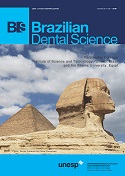The effect of different surface treatments on color and translucency of bilayered translucent nano-crystalline zirconia before and after accelerated aging
DOI:
https://doi.org/10.14295/bds.2019.v22i2.1622Abstract
Objective: Despite the higher translucency of nano-crystalline Y-TZP than the conventional Y-TZP, it couldn’t be used in the anterior region of the mouth in its fully anatomical form without veneering for better esthetics. This study evaluated the color change (?E) and translucency parameter (TP) of the bilayered nano-crystalline zirconia restorations after different treatments of the zirconia surface before and after accelerated aging. Material and Methods: Forty samples of inCoris TZI were cut in the form of discs 15 mm (diameter) and 1mm (thickness) so that after sintering each disc dimensions’ would be 12 mm (diameter) and 0.8 mm (thickness). All discs were colored by dipping in aqueous zirconia coloring solution of shade A2, then divided into four groups according to the type of surface treatment received before sintering; being tribochemical silica coating, zirconia powder deposition, glass grading, and a control untreated group. After sintering, all discs were veneered with a layer of porcelain 0.7 mm (thickness) and 12 mm (diameter). (?E) and TP were measured using VITA Easyshade Compact spectrophotometer before and after accelerated autoclave aging. Results: Different surface treatments applied had significant effect (P<0.05) over ?E and TP. Glass graded group showed the highest ?E value and the least TP value among both un-aged and aged sub-groups. Conclusion: Different surface treatments applied affected the color and translucency negatively where the control untreated group showed the highest TP and the least color deviation from the A2 color parameters. On the other hand, accelerated autoclave aging had no effect over translucency or color.
Keywords
Aging; Ceramic restoration; Color; Translucent.
Downloads
Downloads
Additional Files
- Figure 1: Diagramatic drawing showing a specially designed mold for glass layer thickness adjustment.
- Figure 2: Bar chart showing mean of L* value in relation to different surface treatments before and after aging.
- Figure3: Bar chart showing means of a* value in relation to different surface treatments before and after aging.
- Figure4: Bar chart showing means of b* value in relation to different surface treatments before and after aging.
- Figure 5: Bar chart showing means of ?E in relation to different surface treatments before and after aging.
- Figure 6: Bar chart showing means of (TP) in relation to different surface treatments before and after aging.
- Copyright Notice document
- Title page
Published
How to Cite
Issue
Section
License
Brazilian Dental Science uses the Creative Commons (CC-BY 4.0) license, thus preserving the integrity of articles in an open access environment. The journal allows the author to retain publishing rights without restrictions.
=================




























